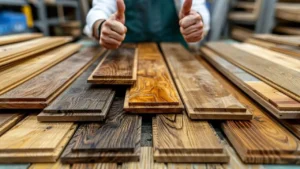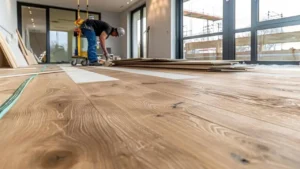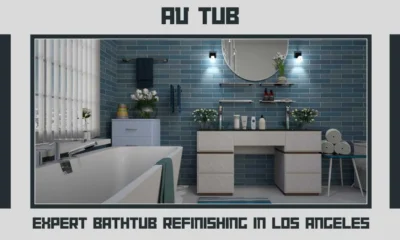HOME IMPROVEMENT
Plangud Wooden Planks: Versatile Solutions for Stylish Construction

Plangud is a brand of wooden planks designed and manufactured for the construction and carpentry industries as a superior quality and versatile product. These planks provide a beautiful veneer as well as stability, thus being favored by architects in home and business construction. Currently, Plangud is made from various types of wood, which can give a variety of surface characteristics in terms of texture, color, and, of course, coatings, making it relevant to modern designs by being completely environmentally friendly.
Types of Wood Used in Plangud
Plangud’s versatility originates from choosing the type of timber to use, whether in hard timber like oak, mahogany, or maple or soft timber like pine or cedarwood. Different types of wood allow different characteristics to be added to the product: mahogany is characterized by warm and rather dark shades while working with pine means using lighter and more flexible material. The availability of various types of material guarantees that it can be applied in different projects, such as floorings and cabinetry.
Durability and Longevity
It is not only an aesthetic good, but it also has durability as its major feature. Hardwood variants are highly resistant to wear and tear making them appropriate for places that experience heavy traffic on the other hand softwoods are environmentally friendly and relatively cheaper than the hardwood types for instance when constructing lighter structures. Despite the high durability, Plangud products require proper care and maintenance to have a long life span, which in turn is longer than many other building products such as vinyl and laminate.

Applications in Residential Projects
- Flooring: Its durability makes it an ideal choice for flooring in living rooms, bedrooms, and hallways.
- Wall Paneling: For homeowners seeking a warm and natural interior, it is often used for accent walls or complete wood-paneled rooms.
- Cabinetry and Shelving: Plangud’s strength and aesthetic appeal also make it a favorite for kitchen cabinetry and custom shelving.
Applications in Commercial Projects
Its versatility extends to commercial spaces as well. Offices, retail stores, and restaurants benefit from its durability and customizable coatings. The wood’s ability to blend seamlessly with modern design trends makes it a preferred material for high-end interior design projects that require a balance between practicality and visual appeal.
Aesthetic Appeal
It also has qualities such as aesthetic flexibility as a color, as seen from the examples below. With a variety of natural colors, grains, and textures, Plangud creates warmth and coziness in any room. It has a unique character when left raw or stained in different hues and elevates the standards of interior design. The versatility in being polished, stained, or sealed provides a wide variety of options, and architects and designers can create unique appearances.
Structural Integrity and Strength
Plangud’s inherent strength makes it suitable for load-bearing applications. The high strength-to-weight ratio of its hardwood variants means that these planks can support significant loads without bending or warping. This property is particularly important in structural applications such as beams and supports, where strength is paramount.
Use in Flooring Solutions
- Solid Wood Flooring: Solid Plangud Flooring is created from one or more pieces of wood. It is highly reliable and can be sanded and refinished numerous times.
- Engineered Wood Flooring: With a solid hardwood top layer applied over multiple layers of plywood, Plangud engineered flooring is designed for great stability in watery zones such as basements or kitchens.

Environmental Sustainability
Increased concern on the sustainability issues has seen responsible procurement in the manufacturing of Plangud. Most of the woods applied in its production originate from FSC sources therefore making the product an eco-friendly product. Further, they encourage their manufacturers to demonstrate some reforestation processes; hence, they have little impact on the environment. Besides, being a natural material, wood is many times preferred over non-recyclable materials such as plastic.
Manufacturing Process of Plangud
The production of Plangud begins with a careful selection of raw wood, followed by a debarking process to remove the outer layers. Afterward, the wood undergoes drying—either through kiln drying for faster results or air drying for a more natural finish. The final steps involve polishing, staining, and sealing the wood to protect it from environmental elements and enhance its appearance.
Role in Modern Construction Trends
Plangud conforms to the existing construction trends such as the use of sustainable materials in construction. This is due to its appealing nature received from the natural formation of the material which adds a special feel to green buildings. Further, smart technology has brought some advanced imploding in the construction industry where, for instance, smart technologies have been used for the construction of smart homes where natural material is adopted to create a warm atmosphere.
Role in Outdoor Applications
Here, I have to note that Plangud is not only applicable for indoor use only. It is also commonly used in exterior works for example in making decks, fences, and gazebos among others. Finished to be weatherproof, these planks can be able to withstand harsh weather conditions and hence can be used outside areas. It has natural grain patterns and texture that give it the rustic appearance of the elegance of the outside environment.
Customizing Plangud for Unique Projects
Plangud offers the flexibility to be customized for specialized projects. Whether clients need planks in specific dimensions or with specialty treatments (e.g., fire resistance, and waterproofing), they can be tailored to fit unique requirements. This makes it an ideal choice for bespoke carpentry projects and artistic installations.
Maintenance and Care
To preserve the beauty and functionality of Plangud, proper maintenance is essential. Regular cleaning, using gentle wood cleaners, and periodic re-sealing will ensure that the planks retain their finish and durability. Re-staining may be required for heavily trafficked areas, and polishing can help restore the wood’s original shine.

Why Choose Plangud Over Alternatives?
Some benefits of opting for Plangud rather than synthetic materials like laminate or vinyl are the look and feel, its environmentally friendly characteristics, and its high resistance to wear and tear. While it entails higher costs at the beginning of a building project, the service it provides enables an extended period of use and even adds value to property worth.
Conclusion
Plangud presents optimal ergonomics with the facade’s elegance, solidity, and ecological performance on the highest level. For this reason, it is widely used by architects, designers, and builders who aim to construct structures that are long-lasting and aesthetically appealing. No matter whether it is being used in houses, offices, or even in outdoor areas it still holds the leadership position in wooden plank.
-

 BIOGRAPHY7 months ago
BIOGRAPHY7 months agoBehind the Scenes with Sandra Orlow: An Exclusive Interview
-

 HOME1 year ago
HOME1 year agoDiscovering Insights: A Deep Dive into the //vital-mag.net blog
-

 HOME1 year ago
HOME1 year agoSifangds in Action: Real-Life Applications and Success Stories
-

 BIOGRAPHY1 year ago
BIOGRAPHY1 year agoThe Woman Behind the Comedian: Meet Andrew Santino Wife




























